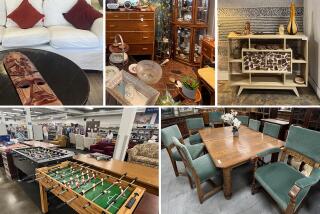Tin an Early Vehicle for Toy Automobiles
- Share via
Automobiles have fascinated men and boys for decades. The toy industry made the first small horseless carriages about 1900, 15 years after the first full-sized vehicles.
A few years after that, toy cars with steam or clockwork mechanisms were made, and the cars could move.
Most of the early toys were relatively accurate representations of a full-sized car. Each year the toys reflected the new designs and body styles.
Georges Carette of Nuremburg, Germany, made many early tin toy cars and other toys from 1886 to 1917. A car could be made in many versions, some with a driver, some without. There were various-colored wheels or body paint, with accessories such as lamps or glass windows.
The cars were made in at least three sizes, ranging from 22 centimeters (8 3/4 inches) to 40 centimeters (15 3/4 inches).
Collectors look for all early toy tin cars and pay high prices for examples in good condition.
*
Question: I saw a set of Heywood-Wakefield 1950s blond wood dining room chairs pictured in an auction catalog. The chairs were described as “dog-bone chairs.” What does that mean?
*
Answer: Look at the backs of the chairs. The description “dog-bone” refers to the shape of the hole in the chair backs.
The Heywood-Wakefield Co., whose roots can be traced back to 1826, made blond, modern furniture from the 1930s through the ‘50s. The furniture, including bedroom sets, dining sets, desks and chairs, is growing in popularity among collectors.
*
Q My mother gave me a large, rectangular platter that she said came to the United States with my Irish grandparents around the turn of the century. It is marked on the back with a pyramid surrounded by a leafy branch. Below the mark is the name “Wallis Gimson & Co.” Above it is the number 39268. Was the platter made in Ireland?
*
A Wallis Gimson & Co. made earthenware in the Staffordshire district of England from 1884 to 1890. Your platter is English, not Irish. The mark on your platter is actually a beehive.
*
Q Can you give me any information about my old light-green glass measuring cup? There are measuring lines on one side. The other side has the words “Cream Dove Brand/Peanut Butter/Salad Dressing/Cream Dove Mfg. Co. Inc., Binghamton, N.Y.”
*
A You have an advertising measuring cup from the 1920s or ‘30s. Many food companies of that period contracted with glass makers to make measuring cups as product premiums or giveaways.
Your cup was probably made by the Hazel Atlas Glass Co. Advertising cups such as yours sell for $20 to $30.
*
Q I have an old mechanical razor in its original case. The gold-colored letters on the case say “Rolls Razor.”
*
A The Rolls Razor “shaving system” was introduced in the United States in the late 1930s. It was manufactured by Rolls Razor Ltd. of London.
The system included a strop and stone hone, frame and mechanism, blade and blade guard, and shaver handle.
The Rolls Razor was expensive, at $15, but the company apparently hoped its name would attract sophisticated buyers.
Unfortunately, there were problems with quality, service was slow and unreliable, and most people were already happy with either the new electric razors or safety razors that used cheap, disposable blades. Rolls was out of business by the early 1950s.
Rolls razor systems are not rare. A complete set sells for less than $100.
*
Q I just purchased a Clark’s spool cabinet. Each drawer has a label. The bottom drawer is labeled “O.N.T.” What do the letters stand for?
*
A “O.N.T.” stands for “Our New Thread,” the brand name for a twisted cotton thread developed in 1866 by George and William Clark of Newark, N.J. The strong thread was designed to be used in sewing machines. The initials “O.N.T.” continue to be used as part of the trademark of Clark’s successor, Coats & Clark Inc.
*
Q Several years ago I bought a dark green, ceramic lamp with metal fittings. The base is decorated with four long vertical leaf forms. The mark on the base includes a crown and the words “Amphora, Austria.”
*
A Your lamp base was made between about 1905 and 1918 by the Amphora Porcelain Factory of Turn-Teplitz, Bohemia (now Trnovany, Czech Republic). Amphora ceramics are popular with collectors.
For a copy of the Kovels’ new loose-leaf booklet listing the record-setting prices paid for art and antiques in 1997 and ‘98, send $3 and a self-addressed, stamped (55 cents) No. 10 envelope to: Record-Setting Prices, Kovels, P.O. Box 22900, Beachwood, OH 44122.
(BEGIN TEXT OF INFOBOX / INFOGRAPHIC)
Current Prices
Figures are recorded from antiques shows, flea markets, sales and auctions throughout the United States. Prices vary in different locations because of local economic conditions.
* Yeast Foam sign, “Makes Delicious Buckwheat Cakes,” pictures little girl eyeing stack of pancakes, paper, 1970, 10 1/2 by 16 inches: $45.
* Blondie paint set, colors in tin, lithograph on lid, 1952: $50.
* Conestoga wagon jack, wrought iron and wood, initials & date “C.G.” & “1758,” 20 inches: $80.
* Rolling pin, blown glass, cobalt blue, gilded transfer designs of ships with verse “Love & Live Happy,” 27 1/2 inches: $165.
* Tom & Jerry Go-Kart plastic toy, friction drive, copyright 1973, Hong Kong, 5 1/2 inches: $200.
* Reed & Barton sterling silver serving spoon, Francis I pattern, 9 inches: $225.
* Ohio Fraktur, “Daniel Sehaey, Smithville, Wayne County, October 11th A.D. 1854,” black, red and yellow, walnut frame, 8 by 10 inches: $480.
* Renaissance revival burl walnut side cabinet, parcel-gilt, mirrored, shelves and drawer, two cabinet doors, open shelf, circa 1880, 73 by 41 by 18 inches: $575.
* Crown Milano candlestick, silver-plated base and socket, maroon glass cylinder, portrait of woman, pink dress, signed, 8 inches, pair: $1,750.
* American silver water pitcher, flowers and thistles, S. Kirk & Sons, 1880, 17 inches: $2,300.






